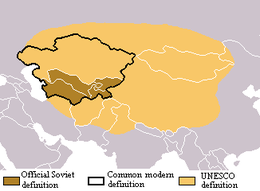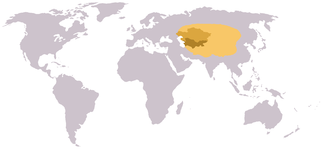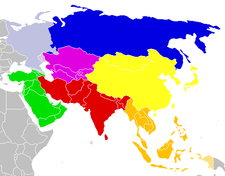- Middle Asia
-
See also: Soviet Central Asia
Middle Asia is a region of Asia from the Caspian Sea in the west, to Mongolia in the east, Afghanistan in the south, and Russia in the north. The geographical term has appeared sometime prior to the 20th century in the Russian Empire and was closely associated with the Russian Turkestan and the Kazakh Steppe.[1] In modern context,[citation needed] all definitions of Middle Asia consensually include the five republics of the former Soviet Union: Kazakhstan, Kyrgyzstan, Tajikistan, Turkmenistan, Uzbekistan, and adjacent steppe areas of Russia. Middle Asia should not be confused with the Central Asia or Inner Asia, the terms that include Middle Asia as their regional part. However, often Middle Asia and Central Asia terms are used interchangeably as, for example, the United Nations considers Middle Asia as the Central Asia. Middle Asia is also closely associated with Turkestan which encompasses areas of Central Asia populated with Turkic people including parts of the western China. Depending on context, the Middle Asian people and states may be referred to as distinctly Middle Asian, or be treated in the greater Central Asian context.
The UNESCO general history of Middle Asia, written just before the collapse of the USSR, defines the region based on climate and uses far larger borders. According to it, Middle Asia includes western parts of Mongolia, northern parts of Tibet, northeast Iran (Golestan, North Khorasan, and Razavi provinces), northern Afghanistan, Northern Areas and the N.W.F.P. province of Pakistan, Kashmir and Ladakh, central-east Russia south of the Taiga, and the former Central Asian Soviet Republics (the five "Stans" of the former Soviet Union).
The areas of the Central Asia that are excluded from the Middle Asia are the Republic of Mongolia, Afghanistan, northern and western Pakistan, north-eastern Iran, Jammu and Kashmir, northern and western portions of the People's Republic of China including Xinjiang, Tibet, Qinghai, Gansu, western Sichuan, northwestern Yunnan and Inner Mongolia, as well as forested parts of Siberia, Russia.
The areas of the Inner Asia that are excluded from the Middle Asia are all those excluded from the Central Asia, plus the areas of the Uralic peoples (Finno-Ugrian and Nenets).[2]
Prior to Stalin's rule[citation needed][dubious ] in Former USSR, the Middle Asia area was also referred to as Turkestan, used in many text books. Then the Soviet Union introduced a most limited official definition of the "Middle Asia" within its borders as consisting solely of Kazakhstan, Uzbekistan, Turkmenistan, Tajikistan, and Kyrgyzstan, excluding the esternmost areas under control of USSR, China, or other states. This definition was sometimes used outside the USSR in that period.
In the literature, the region is also defined based on past and present ethnicity, and in particular, areas populated by Eastern Turkic, Eastern Iranian, or Mongolian peoples. These areas include Xinjiang Uyghur Autonomous Region, the Turkic regions of southern Siberia, the five republics, and Afghan Turkestan. Afghanistan as a whole, the Northern Areas of Pakistan and the Kashmir Valley may also be included. The Tibetans and Ladakhi are also included. In many of the aforementioned cases, the mentioned peoples are considered the "indigenous" peoples of the vast region with its distinct history and economy.
Contents
Geography
Middle Asia has its distinct geography, defined by elevated aridness. The predominant landscape is flat steppes, interrupted by rivers that historically served as oases centers of agriculture, and surrounded by mountain ranges and northern taiga forests. The geography of Middle Asia includes high passes and mountains (Tian Shan), vast deserts (Kara Kum, Kyzyl Kum, Taklamakan), and especially treeless, grassy steppes. The vast steppe areas of Central Asia are considered together with the steppes of Eastern Europe as a homogenous geographical zone known as the Euro-Asian Steppe. Much of the land of Middle Asia is too dry or too rugged for farming.
A majority of the people earn a living by herding livestock. Industrial activity centers in the region's cities.
Major rivers of the region include the Amu Darya, the Syr Darya and the Hari River. Major bodies of water include the Aral Sea and Lake Balkhash, both of which are part of the huge west/central Asian endorheic basin that also includes the Caspian Sea.
Both of these bodies of water have shrunk significantly in recent decades due to diversion of water from rivers that feed them for irrigation and industrial purposes. Water is an extremely valuable resource in arid Central Asia, and can lead to rather significant international disputes.
Divisions
The northern belt is part of the Eurasian Steppe. In the northwest, north of the Caspian Sea, Middle Asia is a continuation of the European Steppe. To the northeast, Dzungaria and the Tarim Basin may sometimes be included in Middle Asia. Just west of Dzungaria, Zhetysu (Seven Rivers) is located south of Lake Balkhash and north of the Tian Shan Mountains. Khorezm is south of the Aral Sea along the Amu Darya. Southeast of the Aral Sea, Maveranahr is between the Amu Darya and Syr Darya. Transoxiana is the land north of the middle and upper Amu Darya (Cheihun, Oxus). Bactria included northern Afghanistan and the upper Amu Darya. Sogdiana was north of Bactria and included the trading cities of Bukhara and Samarkhand. Khorasan and Margiana approximate northeastern Iran. The Kyzyl Kum Desert is northeast of the Amu Darya and the Karakum Desert southwest of it.
Climate
Since Middle Asia is not buffered by a large body of water, temperature fluctuations are more severe.
According to the WWF Ecozones system, Central Asia is part of the Palearctic ecozone. The largest biome in Central Asia is the Temperate grasslands, savannas, and shrublands biome. Central Asia also contains the Montane grasslands and shrublands, Deserts and xeric shrublands and Temperate coniferous forests biomes.
History
Main article: History of Central Asia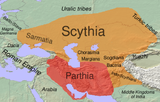 Geographical extent of Iranian influence in the 1st century BC. Scythia (mostly Eastern Iranian) is shown in orange.
Geographical extent of Iranian influence in the 1st century BC. Scythia (mostly Eastern Iranian) is shown in orange.
The history of Central Asia is defined by the area's climate and geography. The aridness of the region made agriculture difficult and its distance from the sea cut it off from much trade. Thus few major cities developed in the region, instead the area was for millennia dominated by the nomadic horse peoples of the steppe.
Relations between the steppe nomads and the settled people in and around Central Asia were long marked by conflict. The nomadic lifestyle was well suited to warfare and the steppe horse riders became some of the most militarily potent peoples in the world, limited only by their lack of internal unity. Any internal unity that was achieved, was most probably due to the influence of the Silk Road, which traveled along Central Asia. Periodically great leaders or changing conditions would organize several tribes into one force, and create an almost unstoppable power. These included the Hun invasion of Europe, the Turkic and Mongolic takeover of Northern China and most notably the Mongol conquest of much of Eurasia.[3]
The dominance of the nomads ended in the 16th century, as firearms allowed settled peoples to gain control of the region. Russia, China, and other powers expanded into the region and had captured the bulk of Central Asia by the end of the nineteenth century. After the Russian Revolution the Central Asian regions were incorporated into the Soviet Union and subdivided into the present five states. Mongolia remained independent but became a Soviet satellite state. However Afghanistan remained an independent buffer between the British and Russian empires.
The Soviet areas of Central Asia saw much industrialization and construction of infrastructure, but also the suppression of local cultures, hundreds of thousands of deaths from failed collectivization programs, and a lasting legacy of ethnic tensions and environmental problems. Soviet authorities deported millions of people, including entire nationalities,[4] from western areas of the USSR to Central Asia and Siberia.[5] From 1959 to 1970, about two million people from various parts of the Soviet Union migrated to Central Asia, of which about one million moved to Kazakhstan.[6]
With the collapse of the Soviet Union five countries gained independence. In nearly all the new states former Communist Party officials retained power as local strongmen. None of the new republics could be considered functional democracies in the early days of independence, although it appears Kyrgyzstan, Kazakhstan and Mongolia have made great strides, unlike Uzbekistan, Tajikistan, and Turkmenistan.
Culture
Religions
Islam is the religion most common in the Central Asian Republics, Afghanistan, Xinjiang and the peripheral western regions, such as Bashkiria. Most Central Asian Muslims are Sunni, although there are sizable Shia minorities in Afghanistan and Tajikistan.
Tengriism, Buddhism and Nestorianism were prominent in Middle Asia prior to the arrival of Islam, and the transmission of Buddhism along the Silk Road eventually brought the religion to China. The Turkic population mostly converted from Tengriism to Islam during the Early Middle Ages. Tibetan Buddhism is common in the southern regions of Siberia, where Shamanism is also popular (including forms of divination such as Kumalak). Increasing Han Chinese migration westward since the establishment of the PRC has brought Confucianism and other beliefs into the region.
Nestorianism was the form of Christianity most practiced in the region in previous centuries, but now the largest denomination is the Russian Orthodox Church, with many members in Kazakhstan. The Bukharian Jews were once a sizable community in Uzbekistan and Tajikistan, but nearly all have emigrated since the dissolution of the Soviet Union and the revival of Islam in the region.
Arts
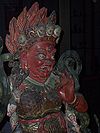 Yama, the Lord of Death.
Yama, the Lord of Death.
At the crossroads of Asia, shamanist practices live alongside and syncretic with Buddhism.
Middle Asia also has an indigenous form of improvisational oral poetry which is over 1000 years old. It is principally practiced in Kyrgyzstan and Kazakhstan by akyns, lyrical improvisationists. They will engage in lyrical battles, the aitysh or the alym sabak. The tradition arose out of early bardic oral historians. They are usually accompanied by a stringed instrument—in Kyrgyzstan, a three-stringed komuz and in Kazakhstan a similar two-stringed instrument.
Some also learn to sing the Manas, Kyrgyzstan's epic poem (those who learn the Manas exclusively but do not improvise are called manaschis). During Soviet rule, akyn performance was co-opted by the authorities and subsequently declined in popularity. With the fall of the Soviet Union it has enjoyed a resurgence, although akyns still do use their art to campaign for political candidates. A 2005 Washington Post article proposed a similarity between the improvisational art of akyns and modern freestyle rap performed in the West.[7]
Territory and region data
Country Area
km²Population
(2009)Population density
per km²Nominal GDP
millions of USD(2009)GDP per capita
(2009)Capital Official languages  Kazakhstan
Kazakhstan2,724,900 16,004,800 6 109,273 $11,300 (2010 forecast) Astana Kazakh, Russian  Kyrgyzstan
Kyrgyzstan199,900 5,482,000 27 4,570 $850 Bishkek Kyrgyz, Russian  Tajikistan
Tajikistan143,100 7,349,145 51 4,982 $766 Dushanbe Tajik  Turkmenistan
Turkmenistan488,100 5,110,000 10 16,197 $3,242 Ashgabat Turkmen  Uzbekistan
Uzbekistan447,400 27,606,000 62 32,816 $1,175 Tashkent Uzbek Territories sometimes included
Country or Territory Area
km²Population
(2009)Population density
per km²Nominal GDP
millions of USD(2009)GDP per capita
(2009)Capital Official languages  Afghanistan (partially)
Afghanistan (partially)647,500 31,889,923 49 14,044 $486 Kabul Pashto, Dari  Pakistan (partially)
Pakistan (partially)803,940 168,925,500 210 166,515 $1,016 Islamabad Urdu, English, Punjabi, Pashto, Sindhi, Balochi  Mongolia (partially)
Mongolia (partially)1,564,116 2,736,800 2 4,203 $1,560 Ulan Bator Mongolian  China- Xinjiang Region
China- Xinjiang Region1,660,000 21,586,300 13 62,520 $2,896 Urumqi Chinese, Uyghur  Russia- Siberia (partially)
Russia- Siberia (partially)13,000,000 36,000,000 4 $1.229 trillion(whole Russia) $8,693(whole Russia) Novosibirsk Russian, Turkic languages Demographics
Main article: Demography of Central AsiaHistorically, the Middle Asia was always sparsely inhabited, due to its extreme aridness and inability to support sustained grain agriculture, which predicated its main production in nomadic animal husbandry. In the period from the end of the 3rd millennium BCE to the 7th c. BCE, Middle Asia was mostly abandoned by its previous Uralic population, which moved north and north-west because of the desertification.[8][9] By a broad definition including Mongolia and Afghanistan, but excluding Pakistan, then more than 90 million people live in Central Asia, about 2% of Asia's total population. Of the regions of Asia, only North Asia has fewer people. Middle Asia has an average population density of 9 people per km², vastly less than the 80.5 people per km² of the continent as a whole.
Languages
The languages of the majority of the Middle Asian population is from the Turkic language group.[10] Turkmen, closely related to Turkish (they are both members of the Oghuz group of Turkic), is mainly spoken in Turkmenistan and into Afghanistan, Iran and Turkey. Kazakh, Kyrgyz and Tatar are related languages of the Kypchak group of Turkic languages, and are spoken throughout Kazakhstan, Kyrgyzstan and Tajikistan, and into Afghanistan and Xinjiang. Uzbek and Uyghur are spoken in Uzbekistan, Tajikistan, Afghanistan and Xinjiang.
Russian, is spoken by around six million ethnic Russians and Ukrainians of Middle Asia,[11] it remains a lingua franca throughout the former Soviet Central Asian Republics. Mandarin Chinese has an equally dominant presence in Inner Mongolia, Qinghai and Xinjiang.
Mongolian is spoken in Tuva, Inner Mongolia, and Xinjiang.
Sogdian was once spoken throughout Middle Asia, but Sogdian, Khwarezmian, and Bactrian languages are now extinct. The East Iranian Pashto is spoken in Afghanistan and northwestern Pakistan, and other minor East Iranian languages, such as Shughni, Munji, Ishkashimi, Sarikoli, Wakhi, and Yaghnobi are spoken in various places in Middle Asia. Varieties of Persian are also spoken in the region, locally known as Darī (in Afghanistan), Tojikī (by Tajiks in Tajikistan), and Bukhori (by the Bukharan Jews in Bukhara).
Dardic languages are predominant in the Northern areas of Pakistan and Kashmir Valley and spread into Ladakh and NWFP and include Shina, Kashmiri and Khowar.
Major languages of Central Asia Turkic languages Iranian languages Other major languages Geostrategy
Main article: Geostrategy in Central AsiaMiddle Asia has long been a strategic location merely because of its proximity to several great powers on the Eurasian landmass. The region itself never held a dominant stationary population, nor was able to make use of natural resources. However, throughout history it numerously became the seat of power for an major states. Middle Asia has been divided, redivided, conquered out of existence, and fragmented time and time again. Middle Asia has frequently served as the battleground for outside powers.
Middle Asia had both the advantage and disadvantage of a central location between four historical seats of power. From its central location, it has access to trade routes to and from all the regional powers. On the other hand, it has been continuously vulnerable to attack from all sides throughout its history, resulting in political fragmentation or outright power vacuum, as it was successively dominated.
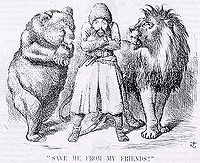 Political cartoon from the period of the Great Game showing the Afghan Amir Sher Ali with his "friends" Imperial Russia and the United Kingdom (1878)
Political cartoon from the period of the Great Game showing the Afghan Amir Sher Ali with his "friends" Imperial Russia and the United Kingdom (1878)
- To the North, the steppe allowed for rapid mobility, first for nomadic horseback warriors like the Huns and Mongols, and later for Russian traders, eventually supported by railroads. As the Russian empire expanded to the East, it would also push down into Central Asia towards the sea, in a search for warm water ports. The Soviet bloc would reinforce dominance from the North, and attempt to project power as far south as Afghanistan.
- To the East, the demographic and cultural weight of Chinese empires continually pushed outward into Central Asia. The Last Chinese Dynasty, the Qing (1644–1912), would consolidate control over Xinjiang and Tibet. With the Sino-Soviet split, China would project power into Middle Asia, most notably in the case of Afghanistan, to counter Russian dominance of the region.
- To the Southeast, India had a continuous presence in the Middle Asia, the demographic and major cultural influence of India, especially Buddhism, shaped the Middle Asia. Several historical Indian dynasties, especially those seated along the Indus river would expand into Central Asia. India's cultural influence has been reduced in the mostly Muslim Middle Asia. From its base in India, the British Empire competed with the Russian Empire for influence in the region in the 19th and 20th centuries.
- To the Southwest, Western Asian powers have expanded into the Southern areas of Central Asia (usually, Uzbekistan, Afghanistan, and Pakistan). Several Persian empires would conquer and reconquer parts of Middle Asia; Alexander the Great's Hellenic empire had a major impact on the Middle Asia; two Islamic empires would exert substantial influence throughout the region; and the modern state of Iran has projected influence throughout the region as well.
In the post–Cold War era, Middle Asia is an ethnic cauldron, prone to instability and conflicts. Projecting influence into the area is no longer just Russia, but also Turkey, Iran, China, Pakistan, India and the United States:
- Russia continues to dominate political decision-making throughout the Middle Asia, although as other countries move into the area Russia's influence is slowly waning, yet it is still a dominant power.
- The United States with its military involvement in the region, and oil diplomacy, is also significantly involved in the region's politics. The United States and other NATO members also exert considerable influence in the Middle Asian nations.
- China, already controlling Xinjiang and Tibet, projects significant power in the region, especially in energy/oil politics (for example, through the Shanghai Cooperation Organization).
- India has geographic proximity to the Middle Asia region, and in addition, enjoys considerable influence on Afghanistan.[12][13] India maintains a military base at Farkhor, Tajikistan and also has extensive military relations with Kazakhstan and Uzbekistan.[14]
- Turkey also exerts considerable influence in the region on account of its ethnic and linguistic ties with the Turkic peoples of Middle Asia and its involvement in the Baku-Tbilisi-Ceyhan oil pipeline. Political and economic relations are growing rapidly (e.g. Turkey recently eliminated visa requirements for citizens of the Central Asian Turkic republics).
- Iran has historical and cultural links to the region, and is vying to construct an oil pipeline from the Caspian Sea to the Persian Gulf.
- Pakistan is termed capable of exercising influence. For some Middle Asia Asian nations, the shortest route to the ocean lies through Pakistan. Pakistan seeks Natural Gas from Middle Asia, and supports the development of pipelines from its countries.
Western observers and governments have claimed that Russia, China and the Middle Asia republics have taken advantage of the War on Terror to increase oppression of certain ethnic groups, including minority separatist movements, as well as some religious groups.
Major cultural and economic centres
City Country Population Image Information Astana  Kazakhstan
Kazakhstan700,000
(2009)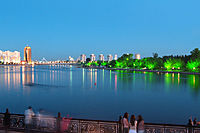
The capital and second largest city in Kazakhstan. After Kazakhstan gained its independence in 1991, the city and the region were renamed "Aqmola". The name was often translated as "White Tombstone", but actually means "Holy Place" or "Holy Shrine". The "White Tombstone" literal translation was too appropriate for many visitors to escape notice in almost all guide books and travel accounts. In 1994, the city was designated as the future capital of the newly-independent country, and again renamed to the present "Astana" after the capital was officially moved from Almaty in 1997. Almaty  Kazakhstan
Kazakhstan1,420,747
(2009)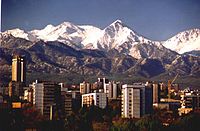
It was the capital of Kazakhstan (and its predecessor, the Kazakh SSR) from 1929 to 1998. Despite losing its status as the capital, Almaty remains the major commercial center of Kazakhstan.Recognized financial centre of Kazakhstan and region. Ashgabat  Turkmenistan
Turkmenistan695,300
(2001)
The capital of Turkmenistan and the biggest city in Turkmenistan. Ashgabat is a relatively young city, growing out of a village of the same name established by Russians in 1818. It is not far from the site of Nisa, the ancient capital of the Parthians, and it grew on the ruins of the Silk Road city of Konjikala, which was first mentioned as a wine-producing village in 2nd century BCE and was leveled by an earthquake in 1st century BCE (a precursor of the 1948 Ashgabat earthquake). Konjikala was rebuilt because of its advantageous location on the Silk Road and it flourished until its destruction by Mongols in the 13th century CE. After that it survived as a small village until the Russians took over in the 19th century.[15][16] Ürümqi  Xinjiang AR, PRC
Xinjiang AR, PRC2,681,834
(2006)The capital and largest city in Xinjiang Uyghur Autonomous Region and the cultural center of Uyghurs.[citation needed] Two thousand years ago Ürümqi was an important town on the northern route of the Silk Road, a vast network of trade routes that also facilitated cultural exchanges throughout Eurasia. Samarkand  Uzbekistan
Uzbekistan596,300
(2008)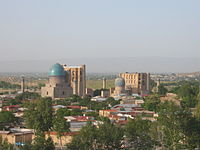
The second-largest city in Uzbekistan and the capital of Samarqand Province. The city is most noted for its central position on the Silk Road between China and the West, and for being an Islamic centre for scholarly study. Bishkek  Kyrgyzstan
Kyrgyzstan1,250,000
(2007)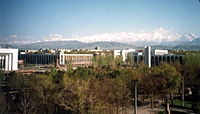
The capital and the largest city of Kyrgyzstan. Bishkek is also the administrative center of Chuy Province which surrounds the city, even though the city itself is not part of the province but rather a province-level unit of Kyrgyzstan. Tashkent  Uzbekistan
Uzbekistan2,180,000
(2008)The capital of Uzbekistan and the biggest city in Uzbekistan. In pre-Islamic and early Islamic times the town and the province were known as "Chach". Tashkent started as an oasis on the Chirchik River, near the foothills of the Tian Shan Mountains. In ancient times, this area contained Beitian, probably the summer "capital" of the Kangju confederacy.[17] Dushanbe  Tajikistan
Tajikistan679,400
(2008)The capital and largest city of Tajikistan. Dushanbe means "Monday" in Tajik and Persian,[18] and the name reflects the fact that the city grew on the site of a village that originally was a popular Monday marketplace. Bukhara  Uzbekistan
Uzbekistan237,900
(1999)The nation's fifth-largest city and the capital of the Bukhara Province of Uzbekistan. Bukhara has been one of the main centres of Persian civilization from its early days in 6th century BCE and since 12th century CE, Turkic speakers gradually moved in. Its architecture and archaeological sites form one of the pillars of the Central Asian history and art. See also
- Agriculture in Central Asia
- Central Asian studies
- Central Asian Union
- Continental pole of inaccessibility
- ECO
- Eurasian nomads
- Euro-Asian Steppe
- Great Game (the rivalry between the British Empire and Tsarist Russia in the 19th century for control of Central Asia)
- Hindutash
- Khotan
- Music of Central Asia
- Soviet Central Asia (1924–1991)
- Survey of India
- Turkistan
- Afghan Turkestan
- International University Of Kyrgyzstan
- University of Central Asia
- Ancient India and Central Asia
Citations
- ^ Mikhail Evgenievich Masson - the founder of the archaeological school in Central Asia
- ^ The Cambridge history of early Inner Asia, Volume 1 By Denis Sinor. Retrieved: 22 August 2009.
- ^ A Land Conquered by the Mongols
- ^ Deported Nationalities
- ^ Anne Applebaum – Gulag: A History Intro
- ^ "Central Asia and the Caucasus: transnationalism and diaspora". Touraj Atabaki, Sanjyot Mehendale (2005). p.66. ISBN 0415332605
- ^ «In Central Asia, a Revival of an Ancient Form of Rap - Art of Ad-Libbing Oral History Draws New Devotees in Post-Communist Era» by Peter Finn, Washington Post Foreign Service, Sunday, March 6, 2005, p. A20.
- ^ Tsvetsinskaya E.A., Vainberg B.I., V. Glushko E.V. "An integrated assessment of landscape evolution, long-term climate variability, and land use in the Amudarya Prisarykamysh delta", Journal of Arid Environments (2002) 51: 363–381 [1]
- ^ L.T. Yablonsky "Stock-Breeders of the Ancient Khоrezm", Russian Academy Of Sciences Institute Of Archaeology, Bulletin of Russian Humanities Foundation, 1999, Issues 1-2, Page 198
- ^ Ethnographic maps
- ^ Robert Greenall, Russians left behind in Central Asia, BBC News, 23 November 2005.
- ^ India: Afghanistan's influential ally
- ^ India, Pakistan and the Battle for Afghanista
- ^ Reiter, Erich. The Impact of Asian Powers on Global Developments. Springer, 2004. ISBN 3790800929, 9783790800920.
- ^ Konjikala: the Silk Road precursor of Ashgabat
- ^ Konjikala, in: MaryLee Knowlton, Turkmenistan, Marshall Cavendish, 2006, pp. 40-41, ISBN 0-7614-2014-2, ISBN 978-0-7614-2014-9 (viewable on Google Books).
- ^ Pulleyblank, Edwin G. 1963. "The consonantal system of Old Chinese." Asia Major 9 (1963), p. 94.
- ^ D. Saimaddinov, S. D. Kholmatova, and S. Karimov, Tajik-Russian Dictionary, Academy of Sciences of the Republic of Tajikistan, Rudaki Institute of Language and Literature, Scientific Center for Persian-Tajik Culture, Dushanbe, 2006.
General references
- Dani, A.H. and V.M. Masson eds. UNESCO History of Civilizations of Central Asia. Paris: UNESCO, 1992.
- Mandelbaum, Michael. ed. Central Asia and the World: Kazakhstan, Uzbekistan, Tajikistan, Kyrgyzstan, and Turkmenistan New York: Council on Foreign Relations Press, 1994.
- Olcott, Martha Brill. Central Asia's New States: Independence, Foreign policy, and Regional security. Washington, D.C.: United States Institute of Peace Press, 1996.
- Soucek, Svatopluk. A History of Inner Asia. Cambridge: Cambridge University Press, 2000.
- Marcinkowski, M. Ismail. Persian Historiography and Geography: Bertold Spuler on Major Works Produced in Iran, the Caucasus, Central Asia, Pakistan and Early Ottoman Turkey, Singapore: Pustaka Nasional, 2003.
- Rall, Ted. "Silk Road to Ruin: Is Central Asia the New Middle East?" New York: NBM Publishing, 2006.
- Stone, L. A' 'The International Politics of Central Eurasia', (272 pp). Central Eurasian Studies On Line: Accessible via the Web Page of the International Eurasian Institute for Economic and Political Research: http://www.iicas.org/forumen.htm
- Weston, David. Teaching about Inner Asia, Bloomington, Indiana: ERIC Clearinghouse for Social Studies, 1989.
External links
- The Spektator - Society, culture and travel articles on Kyrgyzstan and the Central Asian region
- Tourism Networking of Central Asia
- Central Asia Health Review
- Cambridge Central Asia Forum
- Central Asia Gateway
- Central Asia Travel - Travel to Kyrgyzstan, Uzbekistan and Kazakhstan
- You travel guide in Central Asia
- Central Eurasian Studies World Wide
- National Geographic.com - Nat Geo Music: Central Asian Classical Music page
- National Geographic.com - Nat Geo Music: Central Asian Bardic Music page
- Publications on the history of Central Asia Prior to 1917
- Policymakers' Guide to Central Asia
- University of Central Asia
- Discovery Central Asia magazine: Publications on the travel, history and culture of Central Asia
- New Europe News Extensive news coverage and analysis of Central Asia.
- Where West Meets East: The Complex mtDNA Landscape of the Southwest and Central Asian Corridor
- Texas Tech University, full-text examples of Central Asian literature
- International University Of Kyrgyzstan
- [2] The International Politics of Central Eurasia], (272 pp). Central Eurasian Studies On Line: The International Eurasian Institute for Economic and Political Research, 2001.
- Research Institute for Inner Asian Studies (RIFIAS) Library Online Catalog Text Collection is one of North America's premier resources for teaching and research in the history, languages, literatures, geography, religions, and cultures of Inner Asia and is located at Indiana University
- University of Turin-Observatory on Central Asia
- Mansi Mehrotra India and US Strategic Convergence in Central Asia
- The Library: Central on politics, universities, culture, languages, etc.
Countries and territories of Central Asia
Sometimes included: Kazakhstan ·
Kazakhstan ·  Kyrgyzstan ·
Kyrgyzstan ·  Tajikistan ·
Tajikistan ·  Turkmenistan ·
Turkmenistan ·  Uzbekistan
Uzbekistan Afghanistan ·
Afghanistan ·  China (Xinjiang Province) ·
China (Xinjiang Province) ·  Iran (Khorasan Province) ·
Iran (Khorasan Province) ·  Mongolia ·
Mongolia ·  Pakistan (Khyber Pakhtunkhwa, Gilgit Baltistan) ·
Pakistan (Khyber Pakhtunkhwa, Gilgit Baltistan) ·  Russia (Siberia, Tatarstan)
Russia (Siberia, Tatarstan)Regions of the world 
Africa Northern · Sub-Saharan (Central · Southern · Western · Eastern) 
Oceania Australasia (Australia) · Melanesia · Micronesia · Polynesia 
America North (Northern • Middle • Central • Caribbean) · South (Southern • Northern • Western) · Anglo · Latin 
Polar Arctic · Antarctic 
Asia Central · Eastern (Northeastern) · Northern · Southeastern · Southern (Indian subcontinent) · Western (Middle East) 
Oceans World · Arctic · Atlantic · Indian · Pacific · Southern 
Europe Central · Eastern · Northern · Southeastern · Southern · Western 
Seas List of seas Related Continents of the world · List of seas · Physical Earth Categories:- Central Asia
- Regions of Asia
- Biodiversity hotspots
Wikimedia Foundation. 2010.

